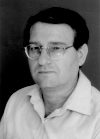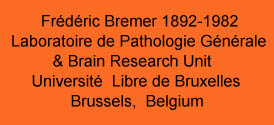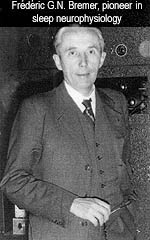
Introduction
Peretz Lavie
Section Editor
In this issue, the historical corner sheds a light on one of the pioneers in sleep neurophysiology, Frédéric G.N. Bremer, the Belgian neuroscientist whose name is linked with the "cerveau isolé" and the "encéphale isolé" preparations. Like many others, Bremer did not start his research career as a sleep researcher. He started out by attempting to understand the cerebellar regulation of the postural muscle tone. These studies were usually done on decerebrated cats leaving the brainstem fully functional. Bremer came up with the brilliant idea that instead of destroying the forebrain, he would leave it intact, but only isolate it from the brainstem by transecting the mesencephalon. "It was my curiosity about how the brain functions after its disconnection from the caudal neuraxis" he said, years later, that motivated him to use this preparation. And indeed the results were dramatic: "When, for the first time, I observed simultaneously the ocular syndrome of the cerveau isolé and its electrocortigram, which was characterized by regular bursts of its 7 to 10 Hz waxing and waning potential waves, I had the shock one experiences in the face of a novel, natural, phenomenon." (From FGN Bremer, The isolated brain and its aftermath. In: The Neurosciences: Paths of Discovery. F Worden, JP Swazey, G Adelman Eds., MIT Press, 1975. pp 268). In these words Frédéric Bremer described the results of his now reknowned experiment. When the ether narcosis had dissipated, he was struck by the intense contraction of the pupils, and the downward and inward dropping of the eyes, that resembled to him the normal sleep of the cat. This observation had led him to the erroneous conclusion that "the functional condition of the isolated forebrain was one of deep sleep." By that, he joined many before him who argued that sleep was passively caused by blocking the brain from incoming sensory stimulation. More on these "passive" theories of sleep can be found in G. Morruzi's "The historical development of the deafferentation hypothesis of sleep" (Proceedings of the American Philosophical Society 108:19-28, 1962). Not knowing about the intricate infrastructure of the sleep process that had become apparent only after the 1953 discovery of REM sleep, all erred in their explanations of the sleep phenomena. Bremer himself admitted that: "If I had been more anatomically minded, I would have concluded from these experiments that between the cervical spinal section and the mesencephalic intercollicular one, there lies a neural structure that is necessary for the maintenance of the waking condition of the forebrain." Thus, he left the discovery of the reticular formation of the brain to Moruzzi and Magoun, 15 years later.
Myriam Kerkhofs sketches the career of Frédéric G.N. Bremer as a researcher and teacher, and pays tribute to this great Belgian experimentalist.

Myriam Kerkhofs Ph.D.
Sleep Laboratory, Erasme Hospital
Université Libre de Bruxelles
Route de Lennik 808, 1070 Brussels
Belgium
E-mail : mkerkhof@ulb.ac.beAfter brilliant medical studies, interrupted by the 1914-1918 war, Frédéric Bremer trained as a neurologist, under the supervision of Professor Pierre Marie at the Hospital of La Salpêtrière in Paris. He then continued to the United States as a "Fellow" of the "Belgian-American Educational Foundation", where he spent one year at Harvard, in the department of Professor Harvey Cushing. Later on, he continued his work in the famous laboratory of Sir Charles Sherrington at Oxford.
In 1924, Bremer joined the University of Bruxelles, and in 1932 he started to teach General Pathology at the Faculty of Medicine. He proved to be an eminent teacher, and in 1934 he became a professor.
At the same time Frédéric Bremer was involved in intense research activity: he was a true "experimenter" and took pleasure in demonstrating the phenomena by carrying out all his experiments himself. This attitude of personally performing the experiments led him to continue pursuing his research activities for several years after he became emeritus in 1962.
As was usual at this time at the University, he combined these academic activities with a medical practice in neurology. He was also a humanist, with interests and knowledge in many different fields.

Bremer's first scientific work was performed in the laboratory of Professor H. Cushing, in collaboration with P. Bailey, on the neurogenic origin of the diabetes insipidus. Another aspect of his research work was dedicated to the inhibitory function of the paleocerebellum on spinal motricity and to the central regulation of muscular tone.
Before arriving in the field of sleep, in 1923, he worked on the control of mastication, curaric atonia, on the influence of novocaine on muscular tone, and on the general physiology of synaptic mechanisms.
Bremer's contribution to sleep started in 1935 in his own laboratory (Laboratoire de Pathologie Générale de l'Université de Bruxelles) with the description of his famous experimental preparation "cerveau isolé" (isolated brain) obtained in the cat by mesencephalic transection (Bremer and Cerveau, 1935). Bremer was influenced by the findings of Von Economo and also by the widely accepted idea that wakefulness was maintained by continuous sensory input to the brain. His "cerveau isolé" preparation produced a state indistinguishable from physiological sleep, with cortical slow waves and miotic pupils. One year later, he introduced the "encéphale isolé" preparation (Bremer, 1935) produced by a transection of the lower part of the medulla. This preparation allowed the study of cortical activity under the influence of sensory impulses. In contrast to the "cerveau isolé" preparation that displayed a sleep-like behavior, "encéphale isolé" cat showed alternations of sleep and wakefulness.
In 1937, he summarized his work (Bremer, 1937) and proposed the hypothesis that sleep does not result from an inhibition of the brain but from a cerebral deactivation by decrease of "cortical tone".
F. Bremer presented his work in Bologna in October 1937, during the Galvani celebrations, where he first became acquainted with Giuseppe Moruzzi. Shortly afterwards, Moruzzi came to work for one year in Bremer's laboratory in Brussels. The well known findings of Moruzzi and Magoun (1949), concerning the role of the brainstem reticular formation, in some aspects shed a new light on Bremer's observations, since this activating reticular formation is situated between the two sections of Bremer experiments. Thus, this formation is disconnected in the "cerveau isolé" preparation, in which the cat sleeps continuously, and is functional in the "encéphale isolé" preparation in which sleep alternates with wakefulness.
Bremer, after having confirmed the Moruzzi and Magoun experiment, analyzed the activation mechanisms of this vigilance system by using the "encéphale isolé" preparation. Bremer and Terzuolo (1954) showed that the cerebral cortex directly influenced the reticular formation by corticofuge pathways, and also that the reticular formation participated in the maintenance of his own vigilance.
Later, also using the "encéphale isolé" preparation, he analyzed the role of intrathalamic recurrent inhibitions on slow wave sleep in the cat, and concluded that an increase in intrathalamic inhibition, resulting from the reduction or the suppression of the action of the ascending reticular formation, is involved in the induction and maintenance of slow wave sleep (Bremer, 1970). In other studies performed on "encéphale isolé" cats, F. Bremer showed that the reticular ascending system is controlled by the preoptic basal area which exerts a tonic inhibitory influence on it (Bremer, 1975).
Frédéric Bremer was 85 when he wrote his famous Editorial Review on Cerebral Hypnogenic Centers (Bremer, 1977) where he suggested that sleep could result from a "chain of disinhibitory and inhibitory processes ending in deactivation of the brainstem arousal system. The prime mover of this positive feedback mechanism would be the slackening of reticular tonic activity".
These lines are too few to summarize the outstanding contribution of F. Bremer to the neurophysiological sciences and to sleep. The major aspects of his personality were his acute intelligence which impressed everyone, his independence, and his irresistible curiosity in the search of the truth which so contrasted with his modesty (Desmedt, 1982).
This brilliant, distinguished, passionate scientist and humanist died in his sleep in April 1982, at the age of 90.
Acknowledgements
I wish to thank Professor Antoine Bremer, Frédéric Bremer's son, who provided useful information and documents.
References
Bremer F. Nouvelles recherches sur le mécanisme du sommeil. C. R. Soc. Biol. 122: 460 - 464, 1935.
Bremer F. L'activité cérébrale au cours du sommeil et de la narcose. Contribution à l'étude du mécanisme du sommeil. Bull. Acad. Roy. Med. Belg 4: 68- 86, 1937.
F. Bremer. Inhibitions intrathalamiques récurrentielles et physiologie du sommeil EEG. Clin Neurophysiol. 28: 1-16, 1970.
F. Bremer. Existence of a mutual tonic inhibitory interaction between the preoptic hypnogenic structure and the midbrain reticular formation. Brain Res. 96, 71-75, 1975.
F. Bremer. Cerebral hypnogenic centers. Ann Neurol. 2, 1-6, 1977.
Bremer F. Cerveau "isolé" et physiologie du sommeil. C. R. Soc. Biol. 118: 1235-1241, 1935.
Bremer F., Terzuolo C. Contribution a l'étude des mécanismes physiologiques du maintien de l'activité vigile du cerveau. Intercation de la formation réticulée et de l'écorce cérébrale dans le processus du réveil. Arch. Intern Physiol., 62: 157-178, 1954.
Desmedt J.E. Eloge académique du Professeur Frédéric Bremer. Bull. Mém Acad. Roy. de Belgique, séance du 22 mai 1982.
Moruzzi G., Magoun HW. Brain stem reticular formation and activation of the EEG. EEG Clin Neurophysiol 1:455- 473, 1949.


